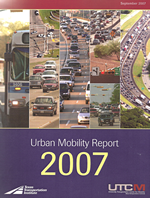Some documents are made available in PDF format. You will need Adobe Reader to view them. 
[ PDF for viewing, 723KB
![]() ]
]
[ PDF for printing, 2.4MB
![]() ]
]
- Director’s Message
- New UTCM Projects Awarded
- RITA Administrators Tour TTI, UTCM
- UTCM Student of the Year
- Spotlight on Education: Graduate Certificate in Transportation Planning
- Spotlight on Technology Transfer: Enhanced Urban Mobility Report
- Spotlight on Research: Transit Services Pilot Study in the Texas Border’s Colonias
- Mobility Colloquium is Launched
- TRB: A Student's Perspective, by UTCM Student of the Year K. Meghan Wieters
Director's Message
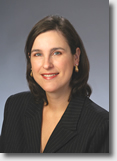
Melissa S. Tooley,
Center Director
UTCM strongly encourages interdisciplinary collaboration. The UTC program stresses the importance of interdisciplinary education as critical to the success of tomorrow’s transportation professionals. Likewise, transportation issues cannot be adequately addressed by a one-dimensional research approach. Research in UTCM’s focus areas must take into account engineering, economic, planning, and political issues in order to develop innovative but implementable results.
Forster Ndubisi’s Transportation Certificate Program (see Spotlight on Education) will offer graduate students a way to include a focus in transportation in any degree program. Courses are being developed by Texas A&M’s Zachry Department of Civil Engineering, the George Bush School of Government & Public Service, the Department of Landscape Architecture & Urban Planning and TTI. The first degrees with this certification are expected to be awarded in May.
Launched last fall, the Mobility Colloquium offers informal and topical lectures with the intent of bringing together researchers with similar interests to stimulate collaboration. These popular seminars have been well attended by TTI staff from all over the state, as well as by faculty, administrators and students from a range of A&M departments with transportation interests.
The Mobility Colloquia have already brought researchers together: at the first colloquium, TTI Associate Research Scientist Sharada Vadali introduced herself to attendees from the Department of Agricultural Economics, and their discussions that day resulted in their submitting two successful UTCM proposals.
Such collaborations are commonplace in the UTCM: of the research projects we have funded to date, almost half of them have involved interdisciplinary collaborations among researchers, faculty and students of TTI and Texas A&M, including the George Bush School of Government and Public Service, the Department of Landscape Architecture and Urban Planning, the Center for Housing and Urban Development, the Department of Agricultural Economics and the Zachry Department of Civil Engineering. As the relationships formed by these research teams continue to develop, it is expected that the percentage of collaborative teams will increase.
A pilot study in the Texas border’s colonias communities addressing flexible transit systems for rural areas is this month’s Spotlight on Research. Dr. Luca Quadrifoglio of Texas A&M’s Zachry Department of Civil Engineering is collaborating with TTI Senior Research Scientist Linda Cherrington. To gather data from local residents for their study, they are utilizing experienced local colonias residents hired and trained by the Center for Housing and Urban Development in the College of Architecture at A&M.
Clearly, UTCM’s emphasis on collaboration is increasing the number of interdisciplinary research partnerships in transportation-related programs across the Texas A&M campus and beyond. This is a benefit that is expected to continue long after the UTCM grant expires.
Collaboratively Yours,
Melissa S. Tooley
[ Top ]
New UTCM Projects Awarded
UTCM’s inaugural Request for Preliminary Proposals (RFPP) yielded 45 submissions by the October 1, 2007 deadline. The group was reviewed and ranked by the UTCM Executive Committee and Advisory Board. Based on these rankings and other criteria, Formal Proposals were invited by the UTCM Executive Committee and Director.
Seventeen projects for FY08 were selected for funding by the UTCM Executive Committee in December 2007. Since that time, two additional projects have been funded by the Executive Committee. These 19 projects total nearly $1.6M, span all of UTCM’s focus areas and include projects in research, education and technology transfer. The projects include collaborative efforts of researchers and students in TTI, five departments and centers at Texas A&M University, three other Texas universities, TxDOT and private industry.
The listing of all FY08 projects can be found here. More information, including all current and completed UTCM projects, project abstracts and biographical information on UTCM PIs can be found on the UTCM website at http://utcm.tamu.edu.
[ Top ]
RITA Administrators Tour TTI, UTCM
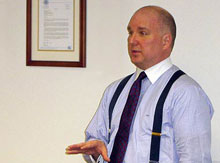
RITA Administrator Paul Brubaker
President Bush appointee Paul Brubaker, Administrator of the USDOT Research and Innovative Technology Administration (RITA), told UTCM and Texas Transportation Institute (TTI) employees, "The world is going to look very, very different in 10 years."
Brubaker was referring to the nation’s growing and shifting population, the price of oil and the challenge of financing infrastructure projects. As RITA Administrator, Brubaker is responsible for coordinating DOT’s $1 billion research budget and is charged with advancing technologies that will improve the US transportation system.
Brubaker’s December 2007 visit to TTI was his first since being sworn in as RITA Administrator last summer. RITA Associate Administrator for Research, Development and Technology Dr. Jan Brecht-Clark accompanied him on the tour. Brecht-Clark oversees the University Transportation Centers program, which includes TTI’s two UTCs, the Southwest Region University Transportation Center (SWUTC) and the University Transportation Center for Mobility (UTCM).
Brubaker and Brecht-Clark were presented overviews of SWUTC and UTCM and toured TTI’s Translink® Laboratory, the Materials and Pavements Lab and TTI’s research and testing facilities at the Riverside campus.
"Dr. Jan Brecht-Clark and I found the briefings and exchanges very useful to understanding the major contributions TTI is making to improve the safety and performance of our national transportation infrastructure. Moreover, TTI is performing a great service to the nation and the state of Texas by training the next generation of national, state and local transportation leaders," Brubaker said. "The commitment and passion of the Aggie community to creating a world-class transportation research facility at A&M was evident from all of the people we met with."
[ Top ]
UTCM Student of the Year
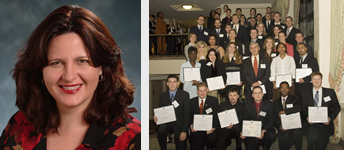
Ms. Meghan Wieters and the 2007 UTC Program SOYs at TRB
"Overseeing the selection of the Outstanding Student of the Year is one of the very best things about being a UTC Director," says UTCM Director Melissa Tooley. "And our first candidate, Meghan Wieters, sets a wonderfully high standard for our Center." Indeed, the Ph.D. Candidate in Urban Regional Science at Texas A&M has held research assistantships from both TTI and the Southwest Region UTC (SWUTC), has a Master’s in Community and Regional Planning from the University of Texas, has professional experience as Principal Planner for the City of Austin, has developed and taught undergraduate courses at A&M and has numerous awards, including SWUTC’s Transportation Ph.D. Student of the Year in 2005. "What’s more," said Tooley, "Meghan is a brilliant, organized young woman with an easy manner and determined attitude."
Meghan’s story of attending TRB as UTCM’s first SOY can be found here.
[ Top ]
SPOTLIGHT ON EDUCATION
Graduate Certificate in Transportation Planning
Principal Investigator: Forster O. Ndubisi, Ph.D., ASLA
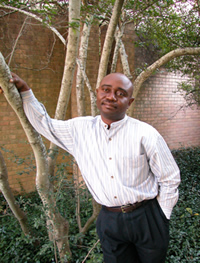
UTCM Researcher
Dr. Forster O. Ndubisi
While the need for an interdisciplinary approach to transportation education is widely recognized by the professional community, there are few educational programs that address the field of transportation in a truly comprehensive, interdisciplinary manner. The absence of such programs creates a unique opportunity for Texas A&M to enhance its position as a national leader in the education of transportation professionals.
Dr. Forster Ndubisi, Professor and Head of Landscape Architecture and Urban Planning, agrees. "Students with an interest in transportation typically pursue degrees in either urban planning or civil engineering," he notes. "Yet increasingly, the transportation profession needs practitioners that can complement these traditional areas with a broader perspective to include the effects of economics, public policy, finance, and urban design on the transportation system."
UTCM Director Dr. Melissa Tooley further stated that "a more holistic view of transportation in society will lead to better solutions to transportation issues such as congestion, border-to-border mobility, rural public transportation and innovative financing methods. These are the focus areas of the UTCM," she noted, "so we are keenly interested in training students to address these issues in the best ways possible."
With this goal in mind Dr. Ndubisi was awarded UTCM funding to develop the Graduate Certificate in Transportation Planning. Open to any Texas A&M graduate student with an interest in transportation, this program offers a multi-faceted, interdisciplinary education in the field of transportation.
Students completing the Certificate Program will begin with a substantive background on the practice of transportation planning. Then, students select specialized instruction in one of three interdisciplinary areas of focus:
- Multimodal Systems Planning
- Transportation and Urban Design
- Transportation Policy
The program will culminate with a comprehensive capstone course, requiring students to partner with students from other areas of specialization to address a real-world transportation problem with a multi-disciplinary approach.
Students completing the Transportation Certificate Program will graduate with both a comprehensive understanding of the role of transportation in contemporary society, as well as an interdisciplinary perspective on how to best address transportation-related problems.
Partnering to Increase Collaboration
The Graduate Certificate in Transportation Planning is being developed by the Department of Landscape Architecture and Urban Planning (LAUP) in the College of Architecture, in partnership with the Texas Transportation Institute (TTI), the Zachry Department of Civil Engineering, and the George Bush School of Government and Public Service. "Lasting partnerships are being formed between the groups involved in developing this program," said Tooley. The new courses will encourage students and faculty to approach transportation research from an interdisciplinary viewpoint. "And since one of the directives of the UTCM is to foster collaboration, we are very excited about that," said Tooley.
Certificate Focus Areas
Multimodal Systems Planning addresses regional transportation issues. It provides an in-depth examination of multimodal solutions for addressing regional mobility, including tools and methods for designing and aligning investments in regional transportation systems.
Transportation and Urban Design addresses the growing demand for balancing conventional mobility concerns with the needs of the built and natural environments. Students with this focus area will be prepared for employment in the growing number of private firms providing specialized transportation design services to both local governments and state DOTs, as well in staff positions in public-sector agencies.
Transportation and Public Policy will develop policy innovators who are able to tailor public policy and finance to emerging transportation needs. Students with this focus will have the educational background needed to assume policy and managerial positions in public-sector entities responsible for transportation planning and investments, such as state and local DOTs, and in the Federal agencies tasked with oversight over the nation’s transportation system.
The first students to earn the Transportation Planning Certificate will graduate in Spring, 2008.
This research project involves the collaborative efforts of:
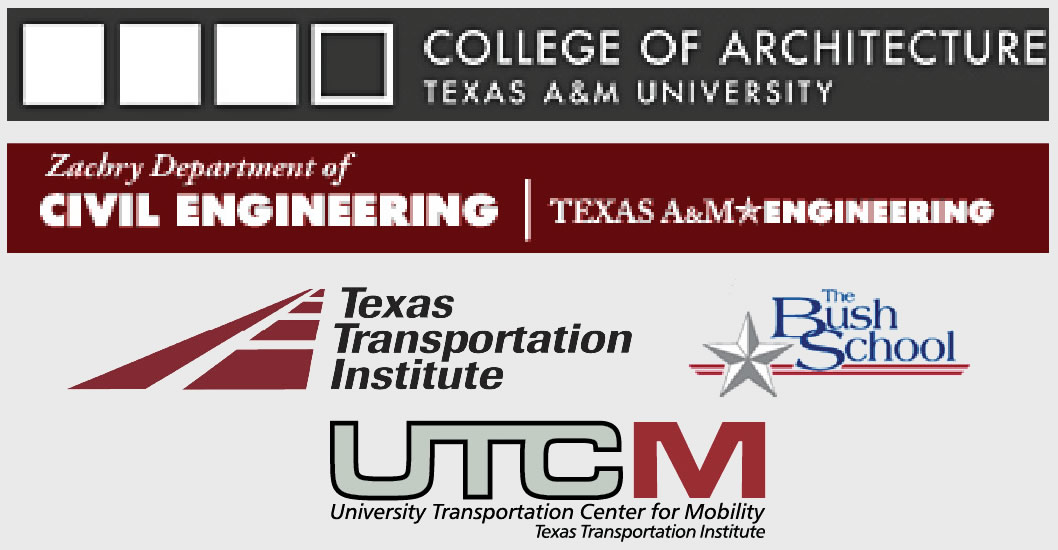
[ Top ]
SPOTLIGHT ON TECHNOLOGY TRANSFER
Enhanced Urban Mobility Report
Principal Investigators: Timothy J. Lomax, Ph.D., P.E. and David L. Schrank, Ph.D.


UTCM Researchers
Dr. Tim Lomax and Dr. David Schrank
On September 18, 2007, the 2007 Urban Mobility Report was released to a media audience anxious to report on our nation’s ever-increasing congestion problem, and TTI mobility analysts Tim Lomax and David Schrank were interviewed by approximately 140 newspapers, radio stations and network television programs.
The Urban Mobility Report, funded in part by the UTCM, is an enormous undertaking for its authors. Promoting its findings presents another challenge, and TTI’s Communications Group worked for weeks prior to the release arranging interviews, writing news releases and posting data to the report’s website, http://mobility.tamu.edu.
"When you see an article about the report or view an interview with us on ABC News, it represents years of data collection and weeks of work to make sure the information gets to the public," Lomax said. "Meetings arranged prior to the release ensured that key decision-maker groups understood the new methodology."
Lomax was in Washington, D.C., as part of a news conference sponsored by ARTBA (American Road and Transportation Builders Association) and APTA (American Public Transportation Association) announcing details of the report’s findings. Most of the network television news groups interviewed him for their evening broadcasts, and Schrank was interviewed live on CNN.
Key findings of the 2007 report include that traffic congestion continues to worsen in American cities of all sizes, creating a $78 billion annual drain on the U.S. economy in the form of 4.2 billion lost hours and 2.9 billion gallons of wasted fuel—that’s 105 million weeks of vacation and 58 fully-loaded supertankers.
Researchers spent two years revising the methodology using additional sources of traffic information to provide more—and higher quality—data on which to base the current study. The result is the most detailed picture yet of a problem that is growing worse in all 437 of the nation’s urban areas. "Congestion is far more complex than is apparent at first glance," Lomax said. "The better the data we use to define the problem, the more successful we will be in addressing its root causes."
Expanding the estimates of the effect of congestion to all 437 U.S. urban areas, the study also provides detailed information for 85 specific urban areas. Report data is accessible on the internet at http://mobility.tamu.edu. Copies of the report may also be ordered from the site.
[ Top ]
SPOTLIGHT ON RESEARCH
Transit Services for Sprawling Areas with Relatively Low Demand Density: A Pilot Study in the Texas Border’s Colonias
Principal Investigator: Luca Quadrifoglio, Ph.D.
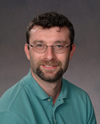
UTCM Researcher
Dr. Luca Quadrifoglio
How do you provide transportation services to sparsely populated, sprawling communities of mostly disadvantaged residents? That is the question being addressed by a UTCM research team led by Dr. Luca Quadrifoglio, Assistant Professor in the Transportation Division of the Zachry Department of Civil Engineering at Texas A&M University and an Associate Research Engineer in TTI’s Operations and Design Division, Signs and Markings Program.
Texas regions sharing a border with Mexico have experienced tremendous population growth in recent decades, resulting in a collection of some 1,800 communities or colonias. Most of the 400,000 residents of the colonias struggle to maintain acceptable living conditions and basic services, including transportation: what transit services do exist are limited and inadequate. The colonias’ transportation problems are compounded by poverty, making it impossible for most residents to afford private vehicles. "This leaves the majority of people with an immediate need for any kind of transportation service," said Quadrifoglio. Moreover, relatively low demand density means that traditional fixed route transit services are not cost effective. "It represents a broken system that is not serving the needs of the community," said Quadrifoglio.
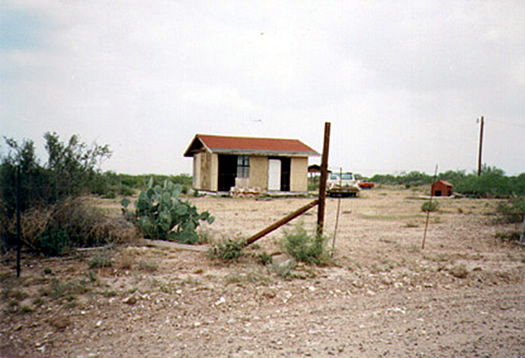
Residence in a Webb County, TX colonia
The good news is that recent innovative and flexible transit concepts intended to respond to the transportation needs of low density areas have been analyzed by researchers and practitioners, and the colonias represent a great opportunity to test these new ideas.
That’s where Dr. Quadrifoglio’s pilot study comes in. Using a representative colonia, El Cenizo, near Laredo, TX, his research team is assessing the current transportation services being offered in the community as well as demand for services. They will then build a model to simulate flexible transit solutions in the area.
In addition to Dr. Quadrifoglio, the research team includes TTI Senior Research Scientist Linda Cherrington and two Texas A&M graduate students, Shailesh Chandra from India and Chung-Wei Shen from Taiwan. The project is jointly supported by the Southwest Region University Transportation Center (SWUTC).
"In the first six months, we were able to develop the survey questionnaire, and we are now distributing it to El Cenizo residents," says Dr. Quadrifoglio. In order to provide the best match of services to the area, it is important that the survey identify how possible solutions might be received. "While designing [the survey]," said Quadrifoglio, "we focused on understanding the current mobility patterns in the area and especially on gathering a sense of how well the residents would respond to a new flexible transit service."
Questionnaires will be delivered door-to-door by a team of 10 "promotoras", actual colonia residents working for Texas A&M’s Center for Housing and Urban Development (CHUD) in the College of Architecture. "I recently visited the area and met with the promotoras. They are experienced at collecting data from their fellow residents and have proven to be the best at gathering valid data from this group," said Quadrifoglio. "They will go door to door interviewing members of each household within El Cenizo." Quadrifoglio expects to collect 250 completed surveys by the end of May.
Concurrently, the team is preparing models to simulate proposed transit service operations and investigate the optimal configuration. Demand data will be updated based on results of the survey. Said Dr. Quadrifoglio, "The project will conclude in August with a completed model that hopefully can be implemented in a future trial there."
More information on this and other UTCM project can be found on our website at http://utcm.tamu.edu under "Projects."
This research project involves the collaborative efforts of:

[ Top ]
Mobility Colloquium Is Launched
One of UTCM’s most visible means of fostering interdisciplinary collaboration and technology transfer is the Mobility Colloquium, launched in the fall of 2007. This casual seminar series presents a variety of speakers from transportation and related disciplines such as architecture, agriculture and public policy, discussing mobility issues as well as topics of general interest. Students are encouraged to attend to broaden their knowledge, and researchers are encouraged to network with interdisciplinary colleagues.
While presenters speak, participants enjoy their brown bag lunches, with cookies provided by UTCM. Lively Q&A follows each presentation. To date, four colloquia have been successfully presented, with an average attendance of 50 people both in person and via videoconferencing units in TTI’s remote offices throughout Texas. Four colloquia have been presented to date:
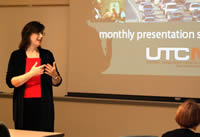
Dr. Melissa Tooley
09.10.2007
"The ABCs of UTCM: Who We Are and How to Get Funded"
Melissa S. Tooley, Ph.D., P.E., Director, UTCM
Dr. Tooley offered an introduction to the new UTC at TTI. Tooley reviewed the center’s four focus areas and discussed the center’s Request for Preliminary Proposals that had just been released. She entertained questions from participants on the UTCM funding process.
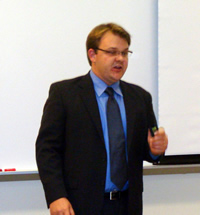
Dr. Eric Dumbaugh
11.12.2007
"Designing for Context: Enhancing Safety and Mobility through Urban Design"
Eric Dumbaugh, Ph.D., Assistant Professor, Department of Landscape Architecture and Urban Planning, Texas A&M University
In a high energy, fast-paced presentation, Dr. Dumbaugh offered current research perspectives on urban planning to increase mobility, safety and functionality in urban environments, including strategic planning of roads and retail areas. He noted that conventional approaches − more lanes, bigger retail centers with greater amounts of parking in front of retail spaces − can lead to increased difficulty managing traffic, pedestrians and land use. "We often focus largely on moving high volumes of traffic on urban arterial roads," reported Dumbaugh. "The problem is that in urban areas, development often clusters along arterials, resulting in lower-speed, access-related traffic mixing with mobility-related traffic. This mix of uses and users results in both higher crash rates and increased traffic congestion, particularly at signalized intersections." He reviewed several case studies in which solutions contrary to the norm yielded positive results.
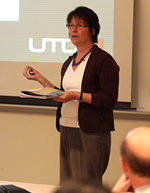
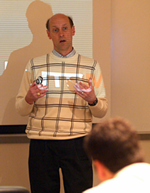
Dr. Johanna Zmud and
Dr. Tim Lomax
01.28.08
"Communicating the Value of Your Research: How to Convince Your Mom That You Contribute to Society"
Johanna Zmud, Ph.D., President, NuStats, Austin, TX
Timothy J. Lomax, Ph.D., Research Engineer, Mobility Analysis Program, Texas Transportation Institute
With a tongue-in-cheek title, Zmud and Lomax presented the results of a National Cooperative Highway Research Program (NCHRP) project designed to help researchers focus on the value of their research, not just the findings.
"We want to help ensure that the hard work of researchers actually makes a difference and is noticed for the value that it has," Lomax said. "The first step, we think, is for us to think about the range of audiences might understand the value of the research. Knowing that will help guide them to the people and groups that are most affected by the results. The next step is to know how to communicate that message to the right audience."
Zmud detailed several case studies in a wide range of topics over the last two decades that were well received by their target audiences. She showed how various methods and outlets were used to successfully promote the value of the research depending on the project. "The common element to creating the widespread perception of value was a strong communication strategy," Zmud said. She recommended that a communication plan be built into proposal budgets. She also said that the case studies clearly show that developing relationships with members of the target audience was the most important element in the communications process.
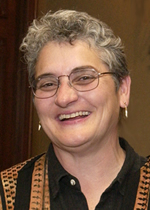
Dr. Karan Watson
02.25.08
"Diversity at Texas A&M: Why So Slow?"
(Co-sponsored by TTI’s Diversity Council)
Karan L. Watson, Ph.D., P.E., Dean of Faculties and Associate Provost, and Regents Professor of Electrical Engineering, Texas A&M University
In honor of Black History Month, the UTCM and the TTI Diversity Council co-sponsored the Mobility Colloquium on diversification efforts of Texas A&M University.
Watson, who served as the Interim Vice President and Associate Provost of Diversity from November, 2005 to September, 2006, noted the slow progress of Texas A&M’s efforts in diversifying its students and faculty. She cited low percentages of minorities at TAMU compared to the percent of college-ready high school graduates in Texas. "For the state we live in, if TAMU does not change its behavior, by 2030 we will be a minority-serving university instead of having a well-represented segment of the population," said Watson, referring to the projected year in which whites will become the minority in Texas.
Watson encouraged everyone to look within themselves and ask what they are doing to improve diversity efforts. "It would be better for us to be seen as the institution that welcomes everyone and for us to get past our schema and our own history," said Watson.
Dr. Watson’s thought-provoking presentation stimulated some interesting discussion both at the Colloquium itself and in the hallways afterward. Said Director Melissa Tooley, "This kind of dialogue will help TTI and TAMU prepare for the workforce of the future."
[ Top ]
TRB: A Student’s Perspective
by K. Meghan Wieters, AICP
Ph.D. Candidate in Urban Regional Science and UTCM Outstanding Student of the Year, 2007
I have heard the stories about the Annual TRB meeting – the thousands of people there, the years where participants trudged through the snow to get to the various hotels and the hundreds of sessions. I had heard the stories, but I never had the opportunity to go; that is, until I received TRB travel expenses as part of the award for the first UTCM Outstanding Student of the Year. Receiving this award was thrilling because now I got to go experience these stories firsthand!
The banquet in which the SOYs received their awards was full of major leaders in the field. I had my picture taken with Former Secretary of Transportation Norman Y. Mineta, shook hands with Congressman James L .Oberstar, and generally enjoyed all the enthusiasm that rippled through the room. I attended primarily pedestrian-oriented sessions and was fond of the discussions related to pedestrian signals. There was lively debate on whether the display of a countdown should or should not be in the MUTCD. Following the discussions on how Washington D.C. (DDOT) implemented the pedestrian countdown signal, I was able to walk around parts of D.C. to view the timing at intersections for pedestrians. And despite being a bit colder than I am used to, I had a great time taking in all the information, exhibits, the people and our nation’s capital.
Offering travel assistance as part of the SOY award affords a great opportunity for students to go to this important conference – ideally before we have to present a paper or poster there. The experience certainly enlightens you as to how large the event is, how to plan the sessions you want to attend, and to consider what research you might present at the meeting in future years.
Thank you for this great opportunity and I hope the UTCM is able to continue to provide this excellent opportunity for students for many more years in the future.
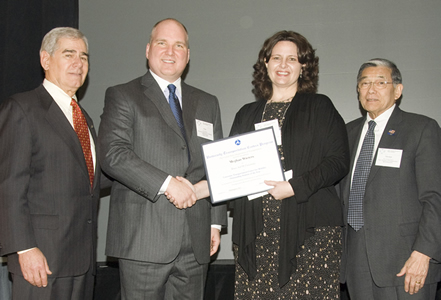
CUTC President Rod Diridon, RITA Administrator Paul Brubaker,
2007 UTCM SOY Meghan Wieters, Former Secretary of Transportation Norman Mineta
[ Top ]



